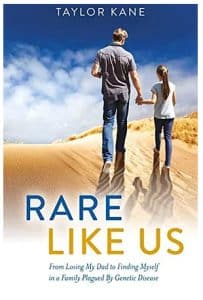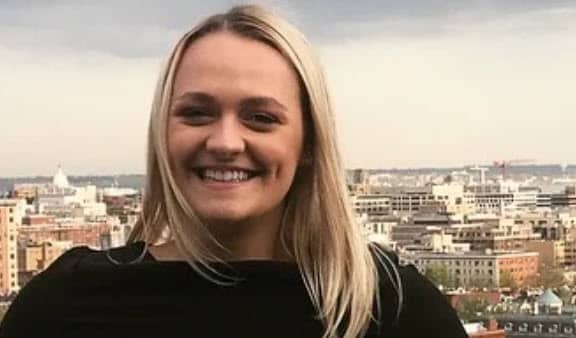Editor’s note: In her book, Rare Like Us: From Losing My Dad to Finding Myself in a Family Plagued By Genetic Disease, Taylor Kane shares the invaluable lessons she learned growing up in a family plagued by a genetic disease so rare that most doctors have never seen it, much less heard of it. Kane is founder and president of Remember the Girls, an international non-profit organization that unites, educates and empowers female carriers of x-linked genetic disorders.
In this Rare Like Us excerpt, Kane describes the relief she felt in meeting with a genetic counselor when Kane was still young. “Learning about my carrier status as a pre-teen,” she said, “was far less traumatic and life-altering than it would have been had I found out later on.” 
Learning that I was an ALD carrier didn’t scare me or make me upset. Frankly, it really didn’t concern me much at all for the next several years—probably because I was so young and my mom had assured me there was no need for me to worry. . .at least not until I was old enough to have children, which seemed a lifetime away.
Over the next few years, however, my mom began to get a little concerned about my carrier status herself when she read online that several studies had determined that up to 20 percent of ALD carriers did, in fact, develop mild to moderate physical symptoms of the disease later in life. So when I was twelve years old, after I began to develop near daily headaches and some unusually high and long-lasting fevers, she made an appointment for me to be evaluated at the Kennedy Krieger Institute by the same doctor who had treated my dad, and to speak to a genetic counselor immediately thereafter.
When the neurologist examined me, however, he quickly dismissed my mom’s worries that my symptoms might be related to ALD. I was doing just fine in that respect, he told us, explaining that while some carriers do develop weakness and spasticity of the legs, as well as bladder and bowel dysfunction, it was extremely rare for these symptoms to manifest before adulthood, and uncommon before middle age.
He also told us that he was optimistic that effective therapies would be available by the time I reached that age. Next, my mom and I met with the genetic counselor, a friendly young woman who confirmed what my mom had read online—that around 20 percent of ALD carriers would eventually develop neurological symptoms later in life, but that it was extremely rare for females to develop the deadly cerebral form of the disease that had taken my dad’s life. She also detailed various reproductive options that could enable me to have a child free of ALD—procedures such as chorionic villus sampling (where the placenta is biopsied in the first trimester of pregnancy to check for genetic mutations), preimplantation genetic diagnosis performed in conjunction with in vitro fertilization (where eggs from a woman and sperm from a man are retrieved and fertilized to create embryos, which are ultimately biopsied and tested prior to implantation into the woman’s uterus), the use of donor eggs, and adoption. Other alternatives might well be available by the time I wanted to have children, she assured me, recommending that I meet with a genetic counselor again prior to starting a family. While this information was a lot to take in, I was relieved to know that I did have options if I decided to have children one day, and that I wouldn’t have to risk having a boy who had a 50 percent chance of developing ALD.
I also learned a great deal about my own family history and the inheritance pattern of ALD. The genetic counselor explained that since ALD was an X-linked recessive disease, I was considered an obligate carrier, meaning that the fact that my father had ALD meant that I necessarily carried the ABCD1 gene mutation. We also discussed the extensive history of ALD that ran throughout my dad’s side of the family, with my mom providing the information she knew about my family tree. While I already knew about my own uncles and aunt, as well as their children, I learned that my dad had two uncles who had died in childhood of unknown causes (well before ALD was discovered), several aunts who were ALD carriers and who had affected children, and numerous extended family members who had either died from, were affected with, or carried the disease. It was frightening to realize how a genetic disease could ravage an entire family, particularly a disease as deadly as ALD.
I will always be grateful to my mom for informing me that I was an ALD carrier and arranging for me to meet with a genetic counselor when I was young. Although all children are different, for me, learning about my carrier status as a pre-teen was far less traumatic and life-altering than it would have been had I found out later on. While it was certainly a little unnerving to realize that I had the same defective gene in my body that took my father’s life, the fact that my childbearing years were still so far away allowed me plenty of time to process what I had learned and come to terms with it. And while I understood that there was a chance that I would develop mild symptoms, that too was well in the future—probably four or five decades away. I suppose that at the time, I was just so relieved that I wouldn’t develop the deadly, cerebral form of ALD that afflicted so many boys born with the defective gene that my prognosis seemed like a blessing.
From Rare Like Us: From Losing My Dad to Finding Myself in a Family Plagued By Genetic Disease, by Taylor Kane, copyright © 2019. Reprinted by permission of the author.
Would you like to see more articles like this? Please consider supporting the Society by joining here: https://participatorymedicine.org/memberships/. Thank you!







Recent Comments